Partial Discharge-Originated Deterioration of Insulating Material Investigated by Surface-Resistance and Potential Mapping
Abstract
:1. Introduction
2. Experimental Methodology
3. Specimen and Measurement Setup
3.1. Specimens
3.2. Measurement Setup
3.2.1. Accelerated Specimen Degradation
3.2.2. DC Charge Sprinkling
3.2.3. Surface-Resistance Mapping
3.2.4. Surface-Potential Mapping
4. Results
4.1. Surface-Resistance Mapping
4.2. Surface-Potential Mapping
5. Discussion
6. Conclusions
Author Contributions
Funding
Data Availability Statement
Conflicts of Interest
References
- Li, C.; Yang, Y.; Xu, G.; Zhou, Y.; Jia, M.; Zhong, S.; Gao, Y.; Park, C.; Liu, Q.; Wang, Y.; et al. Insulating materials for realising carbon neutrality: Opportunities, remaining issues and challenges. High Volt. 2022, 7, 610–632. [Google Scholar] [CrossRef]
- Mazzanti, G. Issues and Challenges for HVDC Extruded Cable Systems. Energies 2021, 14, 4504. [Google Scholar] [CrossRef]
- Rajashekara, K. Power Conversion Technologies for Automotive and Aircraft Systems. IEEE Electrif. Mag. 2014, 6, 50–60. [Google Scholar] [CrossRef]
- Rumi, A.; Lusuardi, L.; Cavallini, A.; Pastura, M.; Barater, D.; Nuzzo, S. Partial Discharges in Electrical Machines for the More Electrical Aircraft. Part III: Preventing Partial Discharges. IEEE Access 2021, 9, 30113–30123. [Google Scholar] [CrossRef]
- Fabiani, D.; Montanari, G.C.; Cavallini, A.; Mazzanti, G. Relation between Space Charge Accumulation and Partial Discharge Activity in Enameled Wires under PWM-like Voltage Waveforms. IEEE Trans. Dielectr. Electr. Insul. 2004, 11, 393–405. [Google Scholar] [CrossRef]
- Lebey, T.; Rumi, A.; Cavallini, A. Challenges for Electrical Insulation Systems in High Voltage Aviation Applications. IEEE Electr. Insul. Mag. 2022, 38, 5–11. [Google Scholar] [CrossRef]
- Mazzanti, G.; Chen, G.; Fothergill, J.; Fu, M.; Hozumi, N.; Lee, J.H.; Li, J.; Marzinotto, M.; Mauseth, F.; Morshuis, P.; et al. The insulation of HVDC extruded cable system joints. Part 1: Review of materials, design and testing procedures. IEEE Trans. Dielectr. Electr. Insul. 2019, 26, 964–972. [Google Scholar] [CrossRef]
- Tanaka, T. Internal partial discharge and material degradation. IEEE Trans. Dielectr. Electr. Insul. 1986, EI-21, 899–905. [Google Scholar] [CrossRef]
- McAllister, I.W. Decay of charge deposited on the wall of gaseous void. IEEE Trans. Electr. Insul. 1992, 27, 1202–1207. [Google Scholar] [CrossRef] [Green Version]
- Tanaka, T.; Uchiumi, M. Two kinds of decay time constants for interfacial space charge in polyethylene-laminated dielectrics. In Proceedings of the 1999 Annual Report Conference on Electrical Insulation and Dielectric Phenomena, Austin, TX, USA, 17–20 October 1999; pp. 472–475. [Google Scholar]
- Niemeyer, L. A generalized approach to partial discharge modeling. IEEE Trans. Dielectr. Electr. Insul. 1995, 2, 4. [Google Scholar] [CrossRef] [Green Version]
- Florkowski, M. Influence of Insulating Material Properties on Partial Discharges at DC Voltage. Energies 2020, 13, 4305. [Google Scholar] [CrossRef]
- Gutfleisch, F.; Niemeyer, L. Measurement and simulation of PD in epoxy voids. IEEE Trans. Dielectr. Electr. Insul. 1995, 2, 729–743. [Google Scholar] [CrossRef]
- Wu, K.; Suzuoki, Y. Effects of discharge area on PD patterns in voids. In Proceedings of the 1999 Annual Report Conference on Electrical Insulation and Dielectric Phenomena, Austin, TX, USA, 17–20 October 1999; pp. 227–230. [Google Scholar]
- Florkowska, B. Partial discharge measurements with computer aided system in polyethyleneterephthalate and polypropylene films. In Proceedings of the 8th International Symposium on High Voltage Engineering, Yokohama, Japan, 23–27 August 1993; pp. 41–44. [Google Scholar]
- Florkowski, M.; Florkowska, B.; Włodek, R. Investigations on post partial discharge charge decay in void using chopped sequence. IEEE Trans. Dielectr. Electr. Insul. 2017, 24, 3831–3838. [Google Scholar] [CrossRef]
- Wu, K.; Ijichi, T.; Kato, T.; Suzuoki, Y.; Komori, F.; Okamoto, T. Contribution of surface conductivity to the current forms of partial discharges in voids. IEEE Trans. Dielectr. Electr. Insul. 2005, 12, 1116–1124. [Google Scholar]
- Florkowski, M.; Florkowska, B.; Kuniewski, M.; Zydron, P. Mapping of discharge channels in void creating effective partial discharge area. IEEE Trans. Dielectr. Electr. Insul. 2018, 25, 2220–2228. [Google Scholar] [CrossRef]
- Florkowski, M.; Kuniewski, M. Correspondence Between Charge Accumulated in Voids by Partial Discharges and Mapping of Surface Charge with PEA Detection. IEEE Trans. Dielectr. Electr. Insul. 2022, 29, 2199–2208. [Google Scholar] [CrossRef]
- Rachmawati; Kojima, H.; Kato, K.; Zebouchi, N.; Hayakawa, N. Electric Field Grading and Discharge Inception Voltage Improvement on HVDC GIS/GIL Spacer With Permittivity and Conductivity Graded Materials (ε/σ-FGM). IEEE Trans. Dielectr. Electr. Insul. 2022, 29, 1811–1817. [Google Scholar] [CrossRef]
- Florkowski, M. Partial Discharges in High-Voltage Insulating Systems—Mechanisms, Processing, and Analytics; AGH Press: Kraków, Poland, 2020; ISBN 978-83-66364-75-2. [Google Scholar]
- Li, C.; Shahsavarian, T.; Baferani, M.A.; Caoa, Y. Tailoring insulation surface conductivity for surface partial discharge mitigation. Appl. Phys. Lett. 2021, 119, 032903. [Google Scholar] [CrossRef]
- Kozioł, M.; Nagi, Ł.; Boczar, T.; Nadolny, Z. Quantitative Analysis of Surface Partial Discharges through Radio Frequency and Ultraviolet Signal Measurements. Energies 2023, 16, 3641. [Google Scholar] [CrossRef]
- Wu, K.; Suzuoki, Y.; Dissado, L.A. Improved simulation model for PD pattern in void considering effects of discharge area. In Proceedings of the 2003 Annual Report Conference on Electrical Insulation and Dielectric Phenomena, Albuquerque, NM, USA, 19–22 October 2003; pp. 32–35. [Google Scholar]
- Illias, H.; Chen, G.; Lewin, P. Partial discharge within a spherical cavity in a dielectric material as a function of cavity size and material temperature. IET Sci. Meas. Technol. 2012, 6, 52–62. [Google Scholar] [CrossRef]
- Wu, K.; Pan, C.; Meng, Y.; Cheng, Y. Effect of void area on PD magnitude uniformity. In Proceedings of the 2013 Annual Report Conference on Electrical Insulation and Dielectric Phenomena, Shenzhen, China, 20–23 October 2013; pp. 1165–1168. [Google Scholar]
- Pan, C.; Wu, K.; Chen, G.; Gao, Y.; Florkowski, M.; Lv, Z.; Tang, J. Understanding Partial Discharge Behavior from the Memory Effect Induced by Residual Charges: A Review. IEEE Trans. Dielectr. Electr. Insul. 2020, 27, 1951–1965. [Google Scholar]
- Florkowski, M. Imaging and simulations of positive surface and airborne streamers adjacent to dielectric material. Measurement 2021, 186, 110170. [Google Scholar] [CrossRef]
- Callender, G.; Lewin, P.L. Modeling partial discharge phenomena. IEEE Electr. Insul. Mag. 2020, 36, 29–36. [Google Scholar] [CrossRef]
- Lemke, E.; Muhr, M.; Hauschild, W. Modeling of Cavity Discharges under AC and DC Voltage—Part II: Opportunities of the Dipole-based PD Model. IEEE Trans. Dielectr. Electr. Insul. 2020, 27, 1853–1860. [Google Scholar] [CrossRef]
- Imburgia, A.; Romano, P.; Rizzo, G.; Viola, F.; Ala, G.; Chen, G. Reliability of PEA Measurement in Presence of an Air Void Defect. Energies 2020, 13, 5652. [Google Scholar] [CrossRef]
- Wu, K.; Okamoto, T.; Suzuoki, Y. Effects of discharge area and surface conductivity on partial discharge behavior in voids under square voltages. IEEE Trans. Dielectr. Electr. Insul. 2007, 14, 461–470. [Google Scholar] [CrossRef]
- Pan, C.; Wu, K.; Du, Y.; Meng, Y.; Cheng, Y.; Tang, J. The effect of surface charge decay on the variation of partial discharge location. IEEE Trans. Dielectr. Electr. Insul. 2016, 23, 2241–2249. [Google Scholar] [CrossRef]
- Kumara, J.R.S.S.; Serdyuk, Y.V.; Gubanski, S.M. Surface potential decay on LDPE and LDPE/Al2O3 nano-composites: Measurements and modeling. IEEE Trans. Dielectr. Electr. Insul. 2016, 23, 3466–3475. [Google Scholar] [CrossRef]
- Pan, C.; Wu, K.; Meng, Y.; Cheng, Y.; Tang, J. The effect of discharge area variation on stochastic characters of PD magnitude. IEEE Trans. Dielectr. Electr. Insul. 2017, 24, 217–226. [Google Scholar] [CrossRef]
- Florkowski, M. Magnetic field modulated dynamics of partial discharges in defects of high voltage insulating materials. Nat. Sci. Rep. 2022, 12, 22048. [Google Scholar]
- Wang, M.; Du, B.X.; Kong, X.; Liang, H.; Ma, Y. High Magnetic Field Affecting Dielectric Polarization and Partial Discharge Behavior of Epoxy Resin. IEEE Trans. Dielectr. Electr. Insul. 2022, 29, 1267–1274. [Google Scholar]
- Noras, M.A.; Pandey, A. Surface charge density measurements. IEEE Ind. Appl. Mag. 2010, 7–8, 41–47. [Google Scholar]
- Takamura, T.; Yashima, M.; Kawamoto, T. Principle of surface charge measurement for thick insulating specimens. IEEE Trans. Dielectr. Electr. Insul. 1998, 5, 497–504. [Google Scholar]
- Nikonov, V.; Bartnikas, R. The Influence of Dielectric Surface Charge Distribution Upon the Partial Discharge Behavior in Short Air Gaps. IEEE Trans. Plasma Sci. 2001, 29, 866–874. [Google Scholar]
- Kacprzyk, R.; Pelesz, A. Problems of potential distribution measurements on objects with a constant charge. Prz. Elektrotech. 2018, 94, 172–175. [Google Scholar]
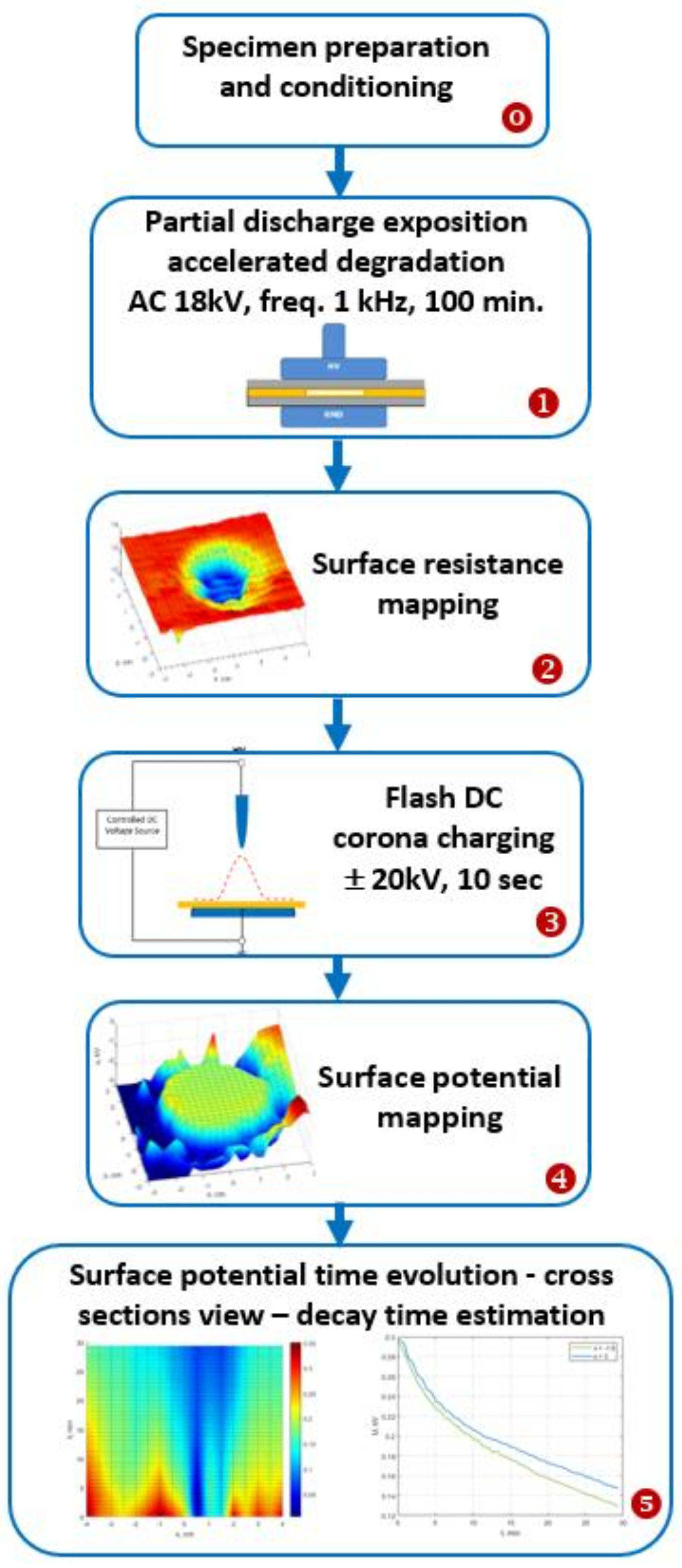
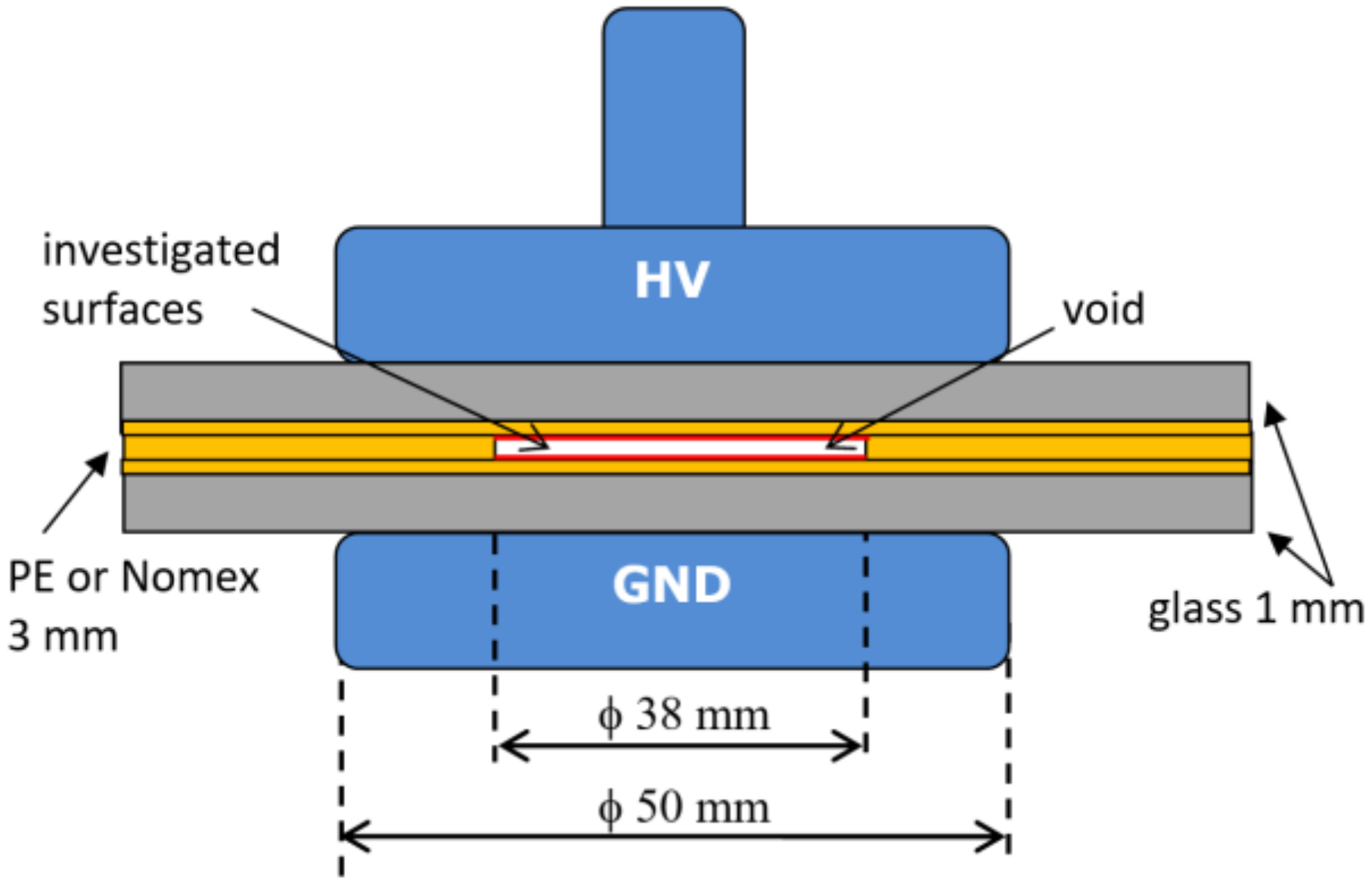


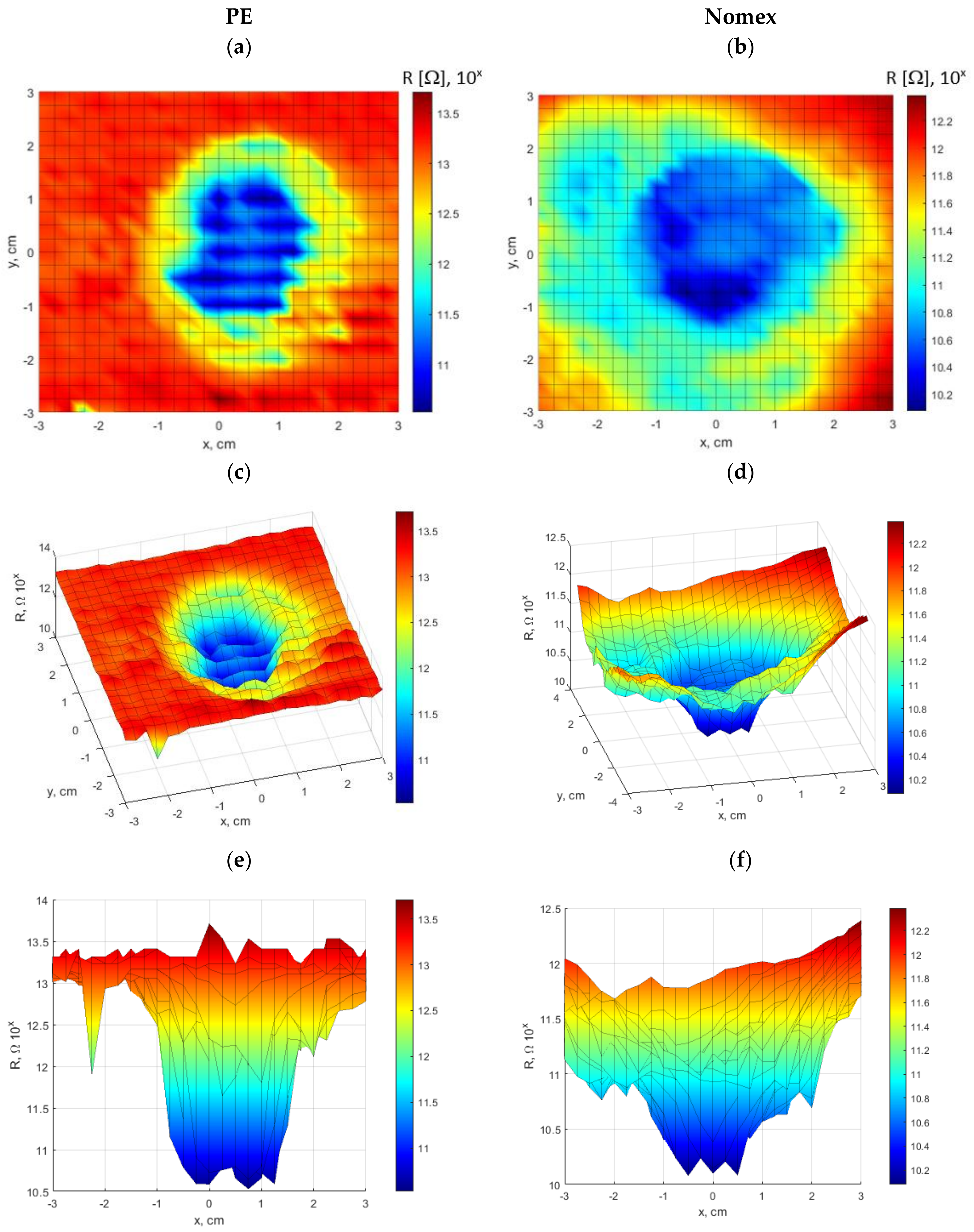
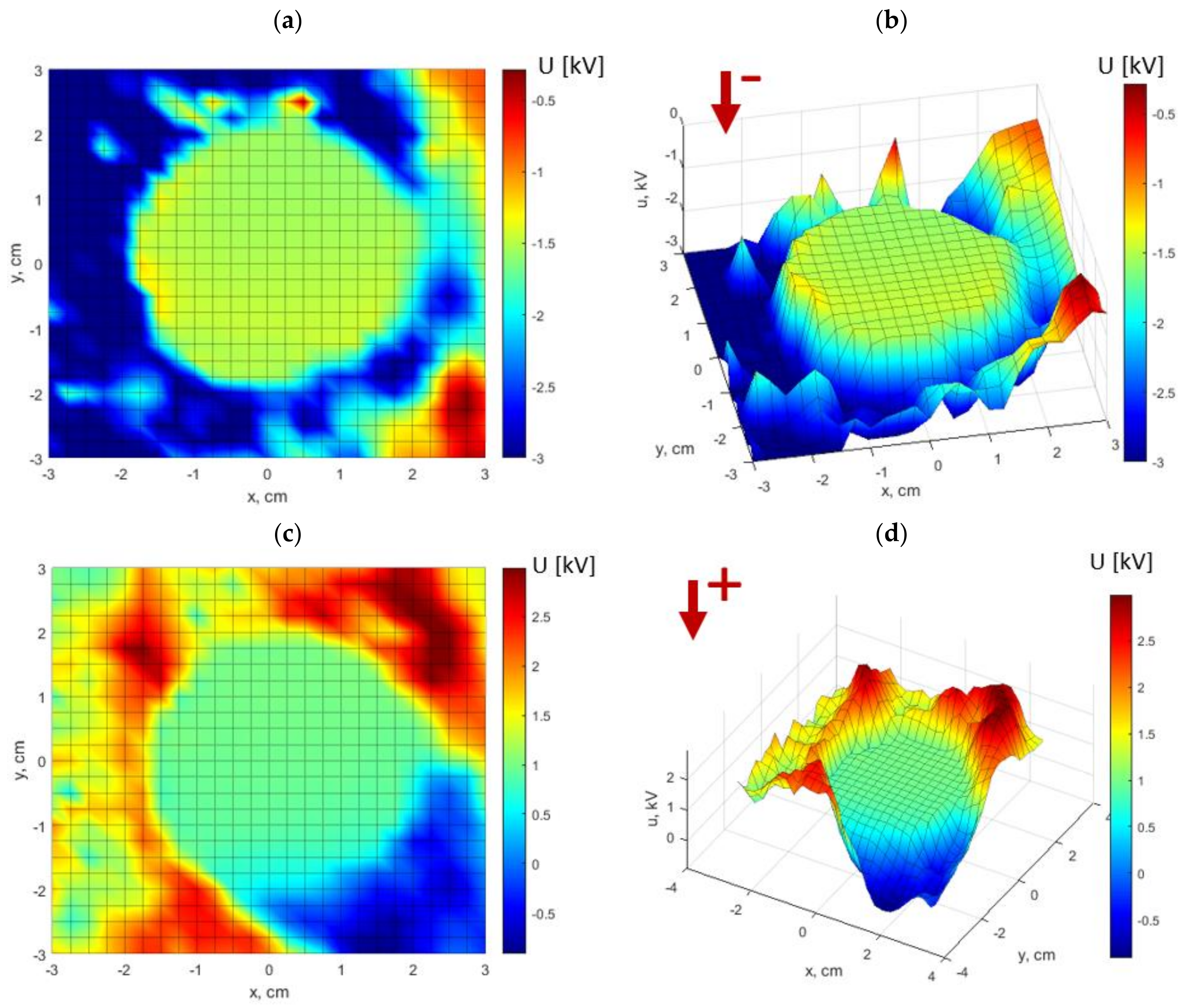

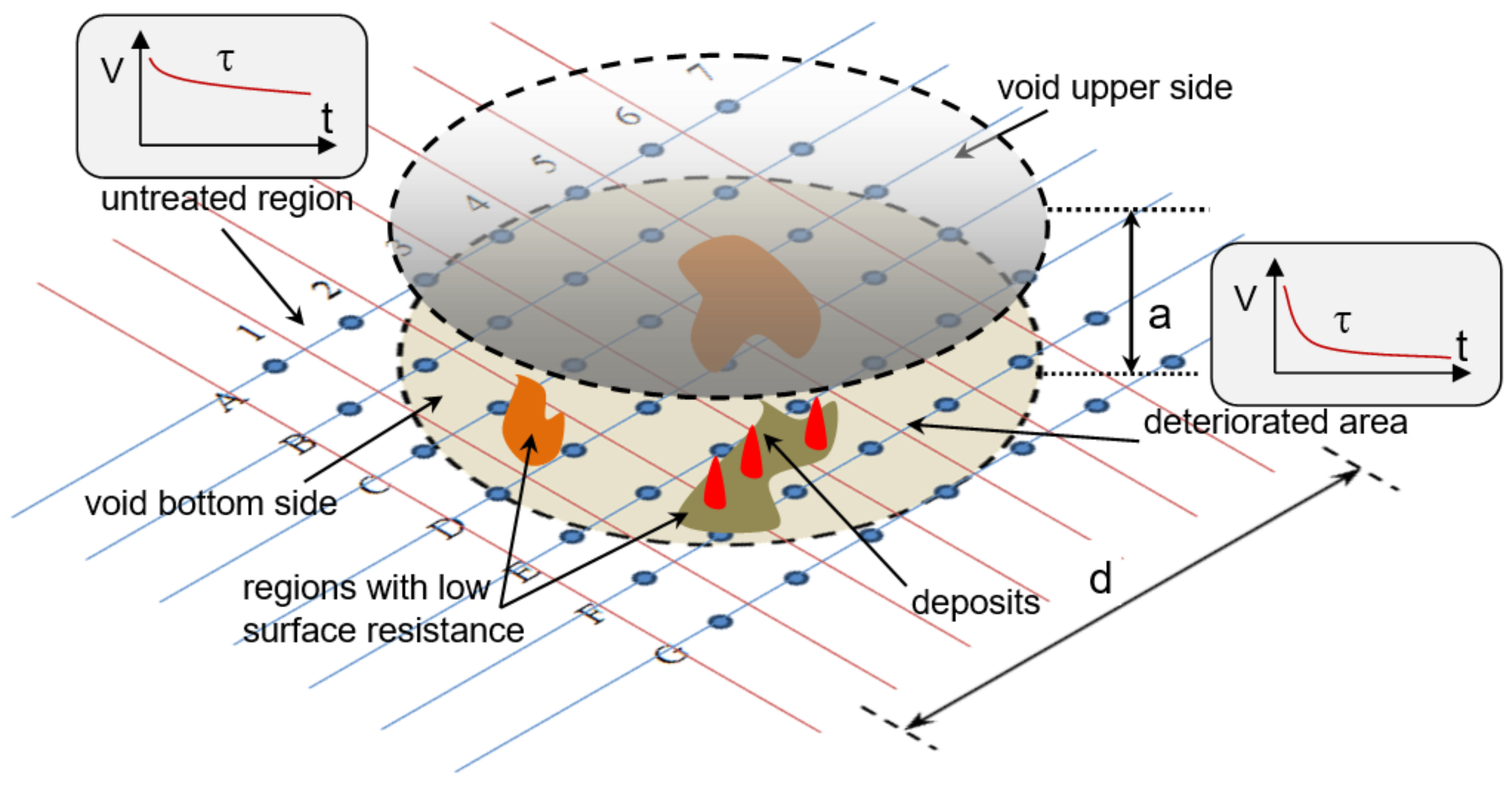


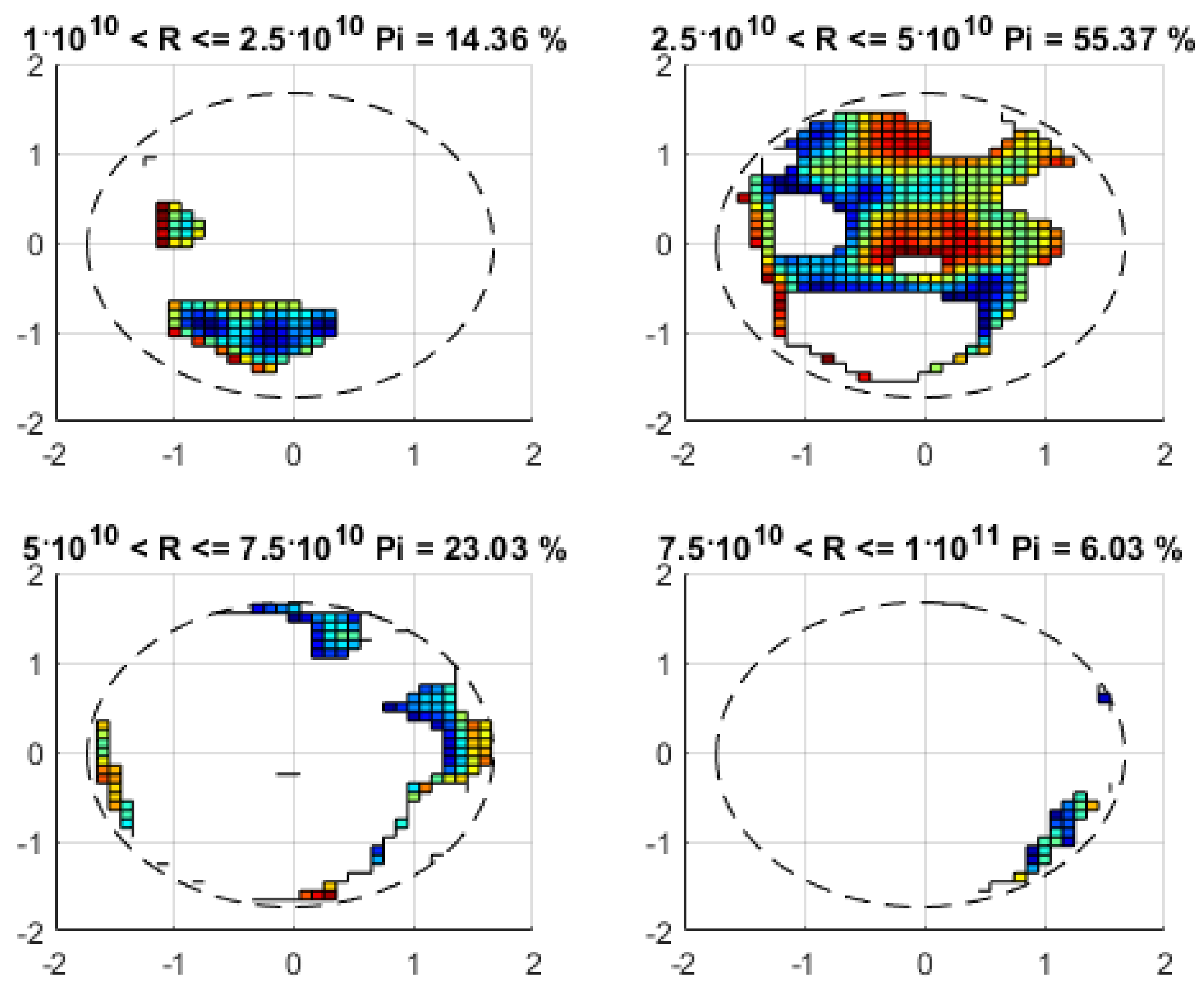
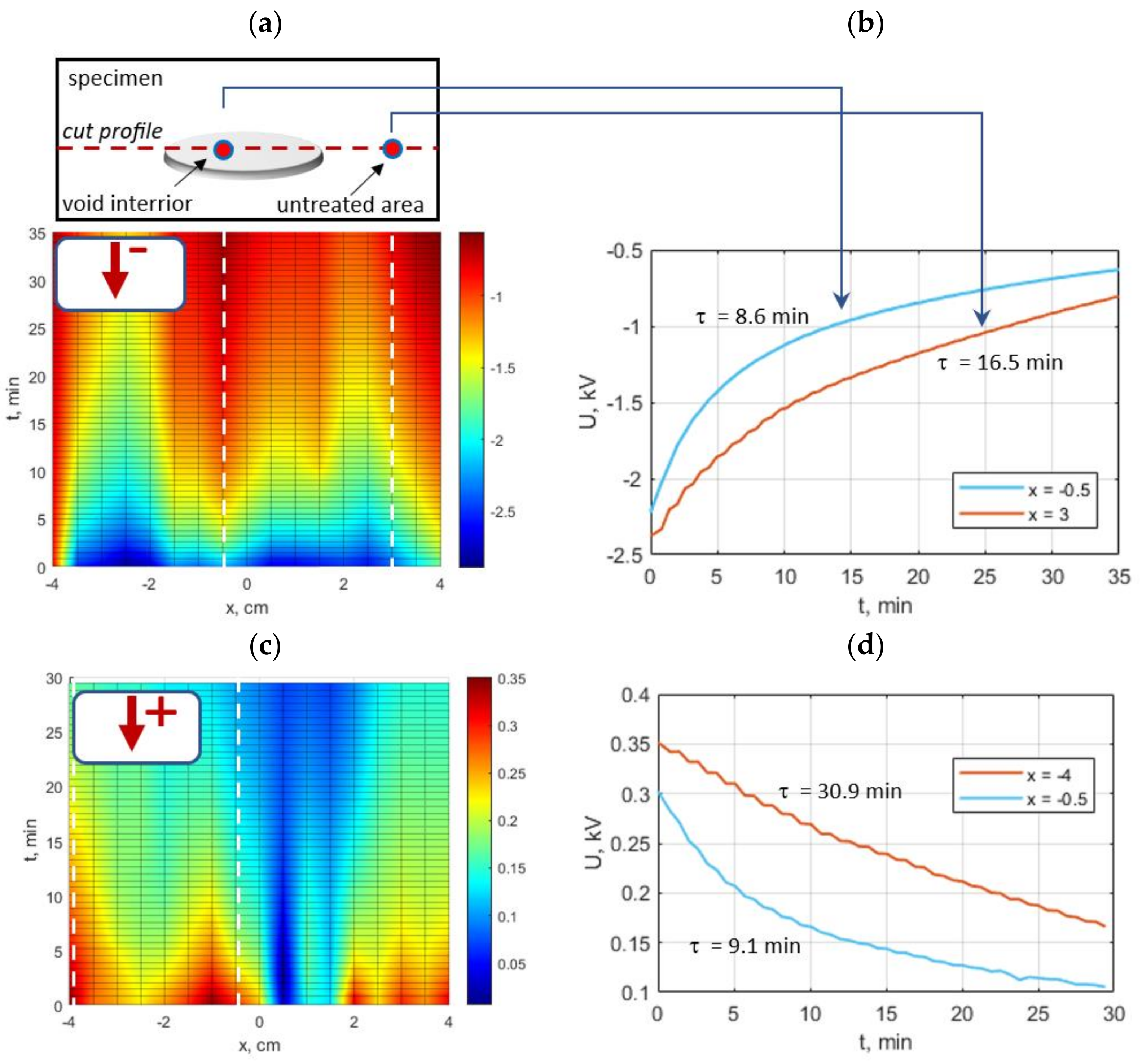
| Nomex 418 | PE | |
|---|---|---|
| Dielectric Strength, AC [kV/mm] | 30 | 40 |
| Dielectric constant, dry | 2.3 | 2.2 |
| Dissipation factor | 0.006 | 0.0009 |
| Volume resistivity [Ω·m] | 1014 | 6 × 1015 |
| Surface resistivity [Ω] | 4 × 1013 | 5 × 1013 |
| Layer thickness [mm] | 0.96 = 8 × 0.12 | 1 |
| Thresholds Thhigh_i [Ω] Bottom Void Wall | PE Pi [%] | Thresholds Thhigh_i [Ω] Bottom Void Wall | Nomex Pi [%] |
|---|---|---|---|
| 1010 < R ≤ 1 × 1011 | 17.0 | 109 < R ≤ 2.5 × 1010 | 14.4 |
| 1 × 1011 < R ≤ 1 × 1012 | 39.3 | 2.5 × 1010 < R ≤ 5 × 1010 | 55.4 |
| 1 × 1012 < R ≤ 1 × 1013 | 42.6 | 5 × 1010 < R ≤ 7.5 × 1010 | 23.0 |
| 1 × 1013 < R ≤ 1 × 1014 | 1.1 | 7.5 × 1010 < R ≤ 1011 | 6.0 |
Disclaimer/Publisher’s Note: The statements, opinions and data contained in all publications are solely those of the individual author(s) and contributor(s) and not of MDPI and/or the editor(s). MDPI and/or the editor(s) disclaim responsibility for any injury to people or property resulting from any ideas, methods, instructions or products referred to in the content. |
© 2023 by the authors. Licensee MDPI, Basel, Switzerland. This article is an open access article distributed under the terms and conditions of the Creative Commons Attribution (CC BY) license (https://creativecommons.org/licenses/by/4.0/).
Share and Cite
Florkowski, M.; Kuniewski, M. Partial Discharge-Originated Deterioration of Insulating Material Investigated by Surface-Resistance and Potential Mapping. Energies 2023, 16, 5973. https://doi.org/10.3390/en16165973
Florkowski M, Kuniewski M. Partial Discharge-Originated Deterioration of Insulating Material Investigated by Surface-Resistance and Potential Mapping. Energies. 2023; 16(16):5973. https://doi.org/10.3390/en16165973
Chicago/Turabian StyleFlorkowski, Marek, and Maciej Kuniewski. 2023. "Partial Discharge-Originated Deterioration of Insulating Material Investigated by Surface-Resistance and Potential Mapping" Energies 16, no. 16: 5973. https://doi.org/10.3390/en16165973







